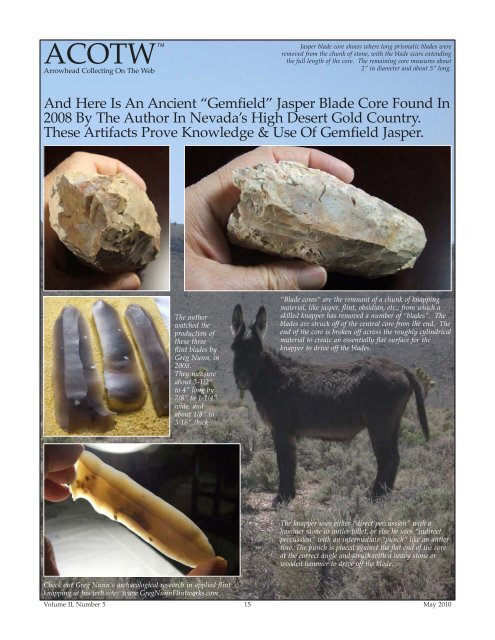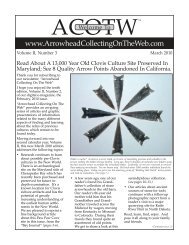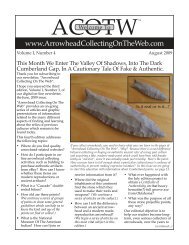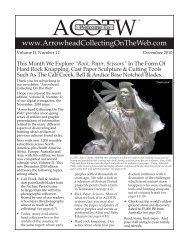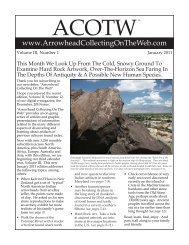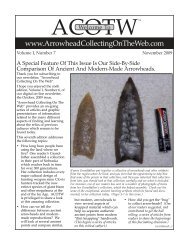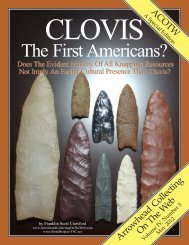14000 Years in the Ozarks - Arrowhead Collecting On The Web
14000 Years in the Ozarks - Arrowhead Collecting On The Web
14000 Years in the Ozarks - Arrowhead Collecting On The Web
You also want an ePaper? Increase the reach of your titles
YUMPU automatically turns print PDFs into web optimized ePapers that Google loves.
ACOTW<br />
<strong>Arrowhead</strong> Collect<strong>in</strong>g <strong>On</strong> <strong>The</strong> <strong>Web</strong><br />
<strong>Arrowhead</strong> Collect<strong>in</strong>g <strong>On</strong> <strong>The</strong> <strong>Web</strong><br />
TM Jasper blade core shows where long prismatic blades were<br />
removed from <strong>the</strong> chunk of stone, with <strong>the</strong> blade scars extend<strong>in</strong>g<br />
<strong>the</strong> full length of <strong>the</strong> core. <strong>The</strong> rema<strong>in</strong><strong>in</strong>g core measures about<br />
2” <strong>in</strong> diameter and about 5” long.<br />
And Here Is An Ancient “Gemfield” Jasper Blade Core Found In<br />
2008 By <strong>The</strong> Author In Nevada’s High Desert Gold Country.<br />
<strong>The</strong>se Artifacts Prove Knowledge & Use Of Gemfield Jasper.<br />
<strong>The</strong> author<br />
watched <strong>the</strong><br />
production of<br />
<strong>the</strong>se three<br />
fl<strong>in</strong>t blades by<br />
Greg Nunn, <strong>in</strong><br />
2008.<br />
<strong>The</strong>y measure<br />
about 3-1/2”<br />
to 4” long by<br />
7/8” to 1-1/4”<br />
wide, and<br />
about 1/8” to<br />
3/16” thick.<br />
Check out Greg Nunn’s archaeological research <strong>in</strong> applied fl<strong>in</strong>t<br />
knapp<strong>in</strong>g at his web site: www.GregNunnFl<strong>in</strong>tworks.com<br />
“Blade cores” are <strong>the</strong> remnant of a chunk of knapp<strong>in</strong>g<br />
material, like jasper, fl<strong>in</strong>t, obsidian, etc., from which a<br />
skilled knapper has removed a number of “blades”. <strong>The</strong><br />
blades are struck off of <strong>the</strong> central core from <strong>the</strong> end. <strong>The</strong><br />
end of <strong>the</strong> core is broken off across <strong>the</strong> roughly cyl<strong>in</strong>drical<br />
material to create an essentially flat surface for <strong>the</strong><br />
knapper to drive off <strong>the</strong> blades.<br />
<strong>The</strong> knapper uses ei<strong>the</strong>r “direct percussion” with a<br />
hammer stone or antler billet, or else he uses “<strong>in</strong>direct<br />
percussion” with an <strong>in</strong>termediate “punch” like an antler<br />
t<strong>in</strong>e. <strong>The</strong> punch is placed aga<strong>in</strong>st <strong>the</strong> flat end of <strong>the</strong> core<br />
at <strong>the</strong> correct angle and struck with a heavy stone or<br />
wooden hammer to drive off <strong>the</strong> blade.<br />
Volume II, Number 5 15<br />
May 2010


